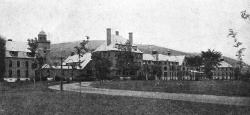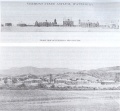Difference between revisions of "Vermont State Hospital"
(→Books) |
M-Explorer (talk | contribs) |
||
| Line 23: | Line 23: | ||
}} | }} | ||
| − | ==History | + | ==History== |
| − | |||
| − | |||
The Vermont State Hospital for the Insane was built in 1890 in Waterbury, Vermont, in response to overcrowded conditions at the Vermont Asylum for the Insane in Brattleboro (Brattleboro Retreat after 1898), Vermont's first and only facility for the care of the mentally ill. Originally built for "the care, custody, and treatment of insane criminals of the state," the Waterbury State Hospital eventually became the temporary or permanent shelter for Vermonters with mild to severe mental disabilities and others who had been committed for epilepsy, depression, alcoholism, or senility. Throughout its history, methods of patient diagnosis and treatment varied according to the philosophy of the superintendent. | The Vermont State Hospital for the Insane was built in 1890 in Waterbury, Vermont, in response to overcrowded conditions at the Vermont Asylum for the Insane in Brattleboro (Brattleboro Retreat after 1898), Vermont's first and only facility for the care of the mentally ill. Originally built for "the care, custody, and treatment of insane criminals of the state," the Waterbury State Hospital eventually became the temporary or permanent shelter for Vermonters with mild to severe mental disabilities and others who had been committed for epilepsy, depression, alcoholism, or senility. Throughout its history, methods of patient diagnosis and treatment varied according to the philosophy of the superintendent. | ||
| Line 36: | Line 34: | ||
More able patients assumed various roles in the work of the institution, including custodial work, maintenance, and tending animals and crops on the institution-run farm in Duxbury. Dr. Stanley also initiated a system of industrial work for patients: assembling clothespins, shoe repair, and crafts such as making chairs, rugs, and baskets. The profits from these enterprises were used for patient entertainment and recreation. | More able patients assumed various roles in the work of the institution, including custodial work, maintenance, and tending animals and crops on the institution-run farm in Duxbury. Dr. Stanley also initiated a system of industrial work for patients: assembling clothespins, shoe repair, and crafts such as making chairs, rugs, and baskets. The profits from these enterprises were used for patient entertainment and recreation. | ||
| − | =Hurricane Irene and | + | ==Hurricane Irene== |
| − | + | In August 2011, hurricane Irene's flood waters flooded the valley which the closed complex stood. At one point the entire complex was underwater and partially destroyed by the hurricane. After the flood waters receded the campus was deemed unusable. The main complex was saved and has been renovated into the State Offices. The complex reopened in December 2015. | |
| − | + | == Books == | |
| − | + | *''Empty beds: A history of Vermont State Hospital'', by Marsha R Kincheloe | |
| − | * | ||
| − | |||
| − | |||
| − | |||
| − | |||
| − | |||
| − | |||
| − | |||
| − | |||
| − | |||
| − | |||
| − | |||
| − | |||
| − | |||
| − | |||
| − | |||
| − | |||
| − | |||
| − | |||
== Images of Vermont State Hospital == | == Images of Vermont State Hospital == | ||
| Line 79: | Line 58: | ||
[[Category:Asylum Books]] | [[Category:Asylum Books]] | ||
[[Category:Past Featured Article Of The Week]] | [[Category:Past Featured Article Of The Week]] | ||
| − | |||
Revision as of 04:49, 23 December 2018
| Vermont State Hospital | |
|---|---|
 | |
| Established | 1889 |
| Construction Began | 1891 |
| Opened | 1891 |
| Closed | October 20, 2011 |
| Current Status | Preserved |
| Building Style | Pavilion Plan |
| Architect(s) | Rand & Taylor |
| Location | Waterbury, VT |
| Peak Patient Population | 1,728 |
| Alternate Names |
|
History
The Vermont State Hospital for the Insane was built in 1890 in Waterbury, Vermont, in response to overcrowded conditions at the Vermont Asylum for the Insane in Brattleboro (Brattleboro Retreat after 1898), Vermont's first and only facility for the care of the mentally ill. Originally built for "the care, custody, and treatment of insane criminals of the state," the Waterbury State Hospital eventually became the temporary or permanent shelter for Vermonters with mild to severe mental disabilities and others who had been committed for epilepsy, depression, alcoholism, or senility. Throughout its history, methods of patient diagnosis and treatment varied according to the philosophy of the superintendent.
Image of Eugene A. Stanley Early twentieth century efforts among reformers to reduce the stigma of mental illness and confinement in state hospitals yielded to the pessimism of the eugenics era, which brought back the stigma with a vengeance. It was during these years that Dr. Eugene A. Stanley directed affairs at Waterbury. An advocate of eugenics, Dr. Stanley testified in favor of the sterilization bills in 1927 and 1931, provided the Eugenics Survey access to patient records, and played an influential role as an advisor to the Eugenics Survey. He was a member of the sub-committee on "Care of the the Handicapped" for the Vermont Commission on Country Life.
Dr. Eugene A. Stanley (1875-1936) was born and raised in New Hampshire and educated at Cleveland University of Medicine and Surgery and Jefferson Medical College. He moved to Waterbury, Vermont in 1899, where he served as a health officer and assistant physician at the Vermont State Hospital from 1908 to 1918. He became Vermont State Hospital superintendent in 1918, succeeding Dr. Walter L. Wasson, who had perished in the influenza epidemic . Stanley held that position until his death in 1936.
During Dr. Stanley's tenure at the Waterbury State Hospital, the patient population grew, peaking at 1,728 during the mid-1930s. In 1931, Stanley convinced the state legislature to construct a new three-story building for the growing number of "acutely disturbed female patients." By today's standards, treatment of patients was primitive, at times barbaric. Typically women in this ward and severe epileptic patients were tied to wooden benches with "camisoles," which secured their arms in back of them. Hydrotherapy, where patients were immersed in continuous baths or placed in wet sheet packs, and "colonic irrigation" were standard treatments for disruptive patients; eventually electro-shock therapy and drug therapy replaced these treatments.
More able patients assumed various roles in the work of the institution, including custodial work, maintenance, and tending animals and crops on the institution-run farm in Duxbury. Dr. Stanley also initiated a system of industrial work for patients: assembling clothespins, shoe repair, and crafts such as making chairs, rugs, and baskets. The profits from these enterprises were used for patient entertainment and recreation.
Hurricane Irene
In August 2011, hurricane Irene's flood waters flooded the valley which the closed complex stood. At one point the entire complex was underwater and partially destroyed by the hurricane. After the flood waters receded the campus was deemed unusable. The main complex was saved and has been renovated into the State Offices. The complex reopened in December 2015.
Books
- Empty beds: A history of Vermont State Hospital, by Marsha R Kincheloe
Images of Vermont State Hospital
Main Image Gallery: Vermont State Hospital




